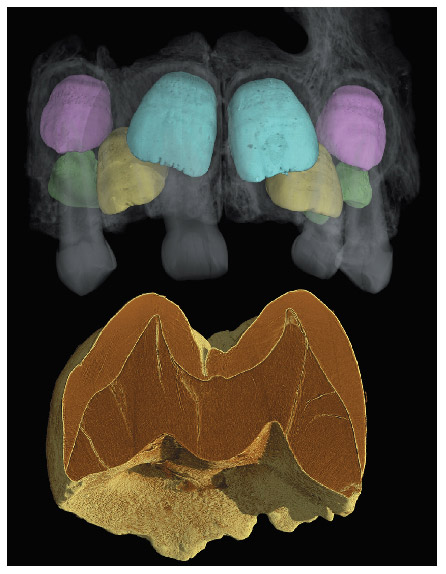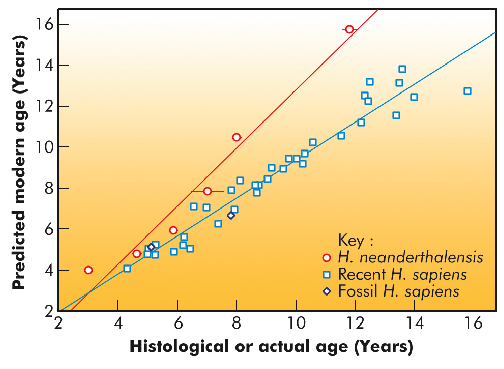- Home
- Users & Science
- Scientific Documentation
- ESRF Highlights
- ESRF Highlights 2010
- X-ray imaging
- Synchrotron reveals human children outpaced Neanderthals by slowing down
Synchrotron reveals human children outpaced Neanderthals by slowing down
Reconstructing the evolution of human development from a severely limited fossil record is a fundamental challenge. While is it well established that humans are developmentally unique among living primates, weaning earlier and reproducing later than expected, the adaptive significance and evolutionary origins of our prolonged childhood are unresolved. Tooth histology, involving quantification of microscopic growth, is the most effective means of determining developmental rates, eruption ages, and age at death in juvenile hominins [1]. Studies of daily and near-weekly biological rhythms in teeth have revealed that Pliocene to Early Pleistocene hominin dental development was more rapid than that of recent humans. However, scientists have been debating for more than 80 years over whether Neanderthals, our evolutionary cousins, grew differently from modern humans. Recent studies have reached contradictory conclusions as methodological limitations have led to incomplete data, and population-level variation has been poorly understood in living and fossil hominins. Here we overcome these limitations by characterising dental development and age at death in several fossil juveniles via non-destructive synchrotron virtual histology [2] (Figure 135).
 |
|
Fig. 135: Synchrotron imaging of the upper jaw of the Engis 2 Neanderthal allows virtual isolation of the permanent teeth (upper image), quantification of tiny growth lines inside the first molar teeth (lower image), identification of its birth line, and determination that it died at age 3. Fossil courtesy of the Université de Liège and Michel Toussaint. Image credits Paul Tafforeau (ESRF) and Tanya Smith (Harvard University and MPI-EVA). To view a 3D animation of the determination of the individual’s age, visit: http://www.heb.fas.harvard.edu/Press |
Although traditional histological methods are destructive, generally prohibiting comprehensive studies of rare fossil material, recent advances in synchrotron imaging now permit accurate three-dimensional virtual histology in a fully non-destructive way. We performed a multiscale microtomographic study on the beamline ID19 using both phase and absorption contrast to assess tooth formation and calculate age at death in a diverse sample of fossil hominins from the past 160,000 years. Our sample includes several invaluable European Neanderthal juveniles, such as the first hominin fossil to be discovered (Figure 135), as well as some of the earliest fossil Homo sapiens populations to have left Africa 90-100,000 years ago. We found that most Neanderthal tooth crowns grew more rapidly than modern human teeth, resulting in significantly faster dental maturation (Figure 136).
 |
|
Fig. 136: Regression of predicted versus actual age for eight fossil juveniles and 36 living humans. Predicted ages are derived from human radiographic calcification standards. Actual ages are calculated from counts and measurements of incremental growth lines in permanent tooth crowns and roots. Fossil Homo sapiens (dark blue diamonds) are represented by Qafzeh 10 and Irhoud 3; Homo neanderthalensis (orange circles) are represented by Engis 2, Gibraltar 2, Krapina Maxilla B, Obi-Rakhmat 1, Scladina, and Le Moustier 1 (from left to right). The comparative recent human sample (blue squares) are western European children of known sex and age. |
In contrast, fossil H. sapiens juveniles show greater similarity to recent humans. These findings are adding to the growing body of evidence that subtle developmental differences exist between us and our Neanderthal cousins, including cranial and post-cranial growth. Furthermore, the recent sequencing of the Neanderthals genome has provided tantalising genetic clues that point to differences in cranial and skeletal development between Neanderthals and modern humans.
Neanderthal dental development appears to be intermediate between early members of our genus (e.g. Homo erectus) and living people, suggesting that the characteristically slow development and long childhood is a recent condition unique to our own species. This extended period of maturation may facilitate additional learning and complex cognition, possibly giving early Homo sapiens a competitive advantage over their contemporary Neanderthal cousins.
Principal publication and authors
T.M. Smith (a,b), P. Tafforeau (c), D.J. Reid (d), J. Pouech (b,c), V. Lazzari (b,c,e), J.P. Zermeno (a), D. Guatelli-Steinberg (f), A.J. Olejniczak (b), A. Hoffman (g), J. Radovcic (h), M. Masrour (i), M. Toussaint (j), C. Stringer (k) and J-J. Hublin (b), Proc. Natl. Acad. Sci. USA 107, 20923-20928 (2010).
(a) Harvard University (USA)
(b) Max Planck Institute for Evolutionary Anthropology (Germany)
(c) ESRF
(d) Newcastle University (UK)
(e) Université de Poitiers (France)
(f) Ohio State University (USA)
(g) Museum für Vor- und Frühgeschichte (Germany)
(h) Croatian Natural History Museum (Croatia)
(i) University Bordeaux II (France)
(j) Service Public de Wallonie (Belgium)
(k) The Natural History Museum (UK)
References
[1] T.M. Smith, J. Hum. Evol. 54, 205-224 (2008).
[2] P. Tafforeau and T.M. Smith, J. Hum. Evol. 54, 272-278 (2008).



